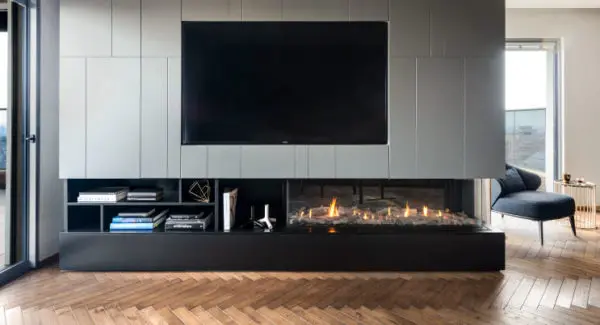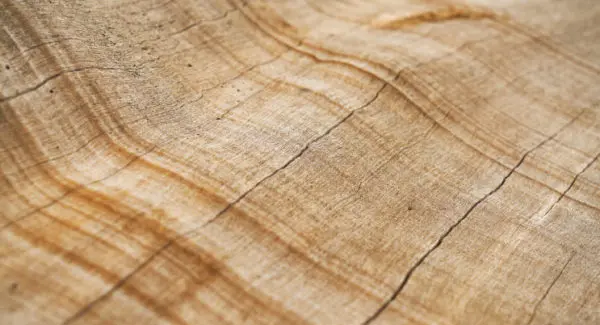Choosing the ideal power for your wood stove is a crucial step to ensure effective and economical heating of your home. A properly sized appliance will guarantee thermal comfort, energy savings, and durability. In this comprehensive guide, we help you precisely determine the capacity suited to your needs based on your living space, your home’s insulation, and your lifestyle habits.
Recommended Power According to Your Home’s Surface Area
To help clarify things, here is a summary table of generally recommended power levels according to the size of your home and its thermal protection level:
| Living Area | Excellent Thermal Protection (RT2012/RE2020) | Standard Thermal Protection | Poor Thermal Protection |
|---|---|---|---|
| 30-40 m² | 2-3 kW | 3-4 kW | 4-5 kW |
| 50-60 m² | 3-4 kW | 5-6 kW | 6-7 kW |
| 70-80 m² | 4-5 kW | 7-8 kW | 9-10 kW |
| 90-100 m² | 5-6 kW | 8-10 kW | 11-12 kW |
Keep in mind these values are indicative and should be adjusted according to the specific characteristics of your home and heating needs. We recommend consulting a Seguin expert to find out the ideal power for your appliance.
How to Calculate the Ideal Power for a Wood Stove?
Determining the necessary thermal capacity for your wood stove is not an exact science, but several reliable methods allow for a precise estimate. Before any purchase, take the time to perform this calculation to avoid sizing errors that could affect your comfort and wood consumption. Our entire team supports you in your wood stove investment and installation project.
The Calculation Method Based on the Area to Heat
The simplest and most widely used method is to estimate the required power based on the surface area to heat. For a standard home with average insulation, the following ratio is generally applied:
1 kW of power per approximately 10 m² of living space
This rule provides a first approximation of the required capacity. For example, to effectively heat an 80 m² home, you would need a wood stove of about 8 kW. However, this approach does not consider important factors such as insulation quality, ceiling height, or geographical location. Moreover, it is preferable to size your appliance according to the size of the area you wish to heat. Indeed, measuring temperature across the entire house can reveal temperature differences depending on the room where your stove is installed.
Factors Influencing Power Choice
Several elements may lead you to adjust the initially calculated capacity:
- Insulation quality: A very well-insulated house (RT2012 or RE2020 standard) requires less power, about 0.45 to 0.6 kW per 10 m², whereas a poorly insulated home will demand more, about 1.2 to 1.5 kW per 10 m².
- Climate of your region: colder areas such as northeastern France require higher capacity.
- Ceiling height: high ceilings (above 2.5 m) increase the volume to heat.
- Home layout: a multi-level home may require different heat distribution.
- Large windows: potential sources of heat loss.
The Volume-to-Power Ratio
For a more precise estimate, you can also calculate according to the volume to be heated:
1 kW per about 25 to 30 m³ of space
To calculate volume, multiply the floor area by the ceiling height. For example, a 50 m² room with a 2.5 m ceiling height has a volume of 125 m³, theoretically requiring a stove of 4 to 5 kW.
This method is especially useful for homes with unusual ceiling heights (mezzanines, converted attics, etc.). Don’t hesitate to consult our wood stove specialists for a personalized evaluation.
What Power Wood Stove for Small Surfaces (30 to 60 m²)?
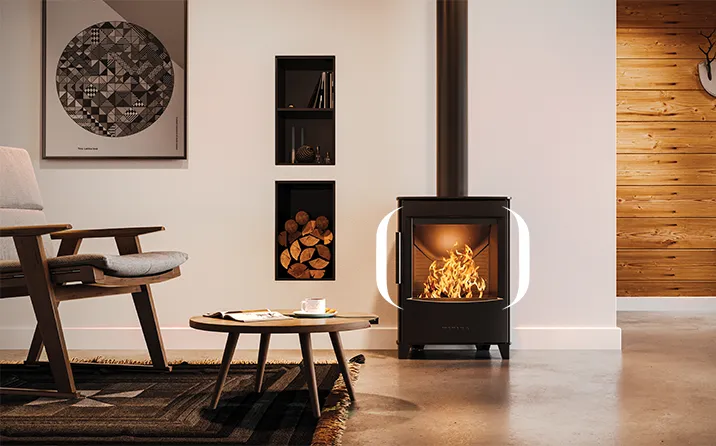
For a studio, apartment, or small house between 30 and 60 m², generally choose a wood stove with a power of 3 to 6 kW. These compact models are perfectly suited for small spaces and provide efficient heating without overheating risk.
For example, the MINI 2 BLACK design stove from Seguin offers an ideal capacity for this type of space while adding an aesthetic touch to your interior.
If your home is particularly well insulated (recent construction or energy renovation), you might consider a 3 kW model, while average to low thermal protection would require 5 to 6 kW.
What Power for Medium Surfaces (70 to 100 m²)?
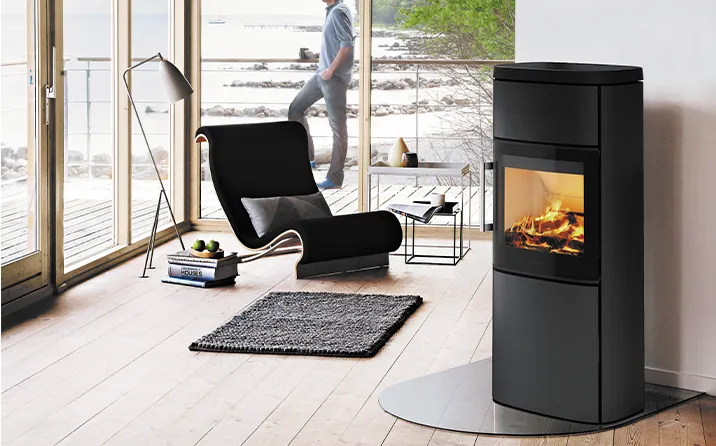
For an average-sized home between 70 and 100 m², the recommended capacity generally ranges between 7 and 10 kW. This range allows efficient heating of the entire living space, including several rooms if the layout permits.
Models like the P530T or the 4660N offer an excellent balance between power and design for this type of area.
If your residence has an open layout promoting warm air circulation (open kitchen-living-dining concept), you might manage with slightly lower capacity. Conversely, a compartmentalized home with many partitions may require a more powerful stove or an additional hot air distribution system.
What Power for Large Surfaces (Over 100 m²)?
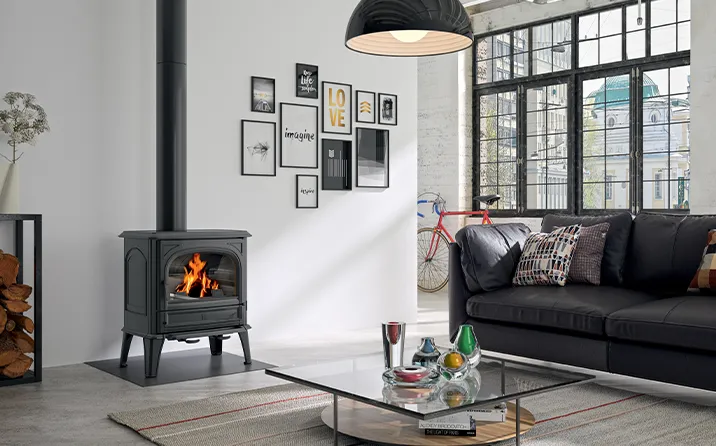
For large homes exceeding 100 m², consider a wood stove of at least 10 to 12 kW, or more depending on the layout and thermal protection. These more powerful models are designed to efficiently heat large volumes.
Models such as SAPHIR or TOPAZE are particularly suitable for large spaces due to their high capacity and ability to distribute heat over a wide area.
For very large homes (150 m² and above), you have several options:
- Multiple medium-capacity stoves distributed in different zones of the home.
- A wood stove coupled with a supplementary heating system.
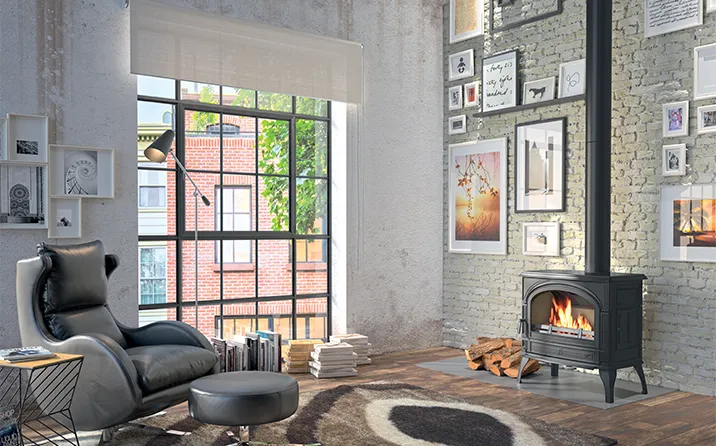
The Importance of Thermal Protection in Power Choice
The insulation of your residence is probably the most decisive factor in choosing your wood stove’s power, sometimes more so than the surface area itself.
Well-Insulated Homes: Reduce Power
In a highly thermally protected home (RT2012, RE2020, or efficient energy renovation), heating needs are significantly reduced. For such homes:
- Reduce the theoretical power calculated by 30 to 40%.
- Prefer appliances with a wide adjustable power range.
A passive or very high energy performance house may only require 0.4 to 0.6 kW per 10 m², nearly half that of a standard home. In this context, choosing an overly powerful stove can cause overheating issues and require constant output reduction, lowering efficiency and increasing pollution.
Poorly Insulated Homes: Increase Power

Conversely, an old poorly insulated house (built before 1980 without energy renovation) has significant heat loss that must be compensated by higher heating capacity:
- Increase the theoretical power by 20 to 50% depending on insulation quality. It’s best to consult a SEGUIN advisor for the appropriate solution.
- Consider aggravating factors (large single-pane windows, uninsulated attics, etc.).
- Take into account exposure to prevailing winds and home orientation.
For very poorly insulated homes, it may be wise to consider thermal protection improvements before installing a wood stove. This will not only reduce power needs but also improve comfort and reduce wood consumption.
Risks of Incorrect Sizing
Choosing a wood stove with a capacity not suited to your home can lead to various problems affecting comfort, budget, and even appliance durability.
Consequences of an Undersized Wood Stove
A stove with insufficient capacity will struggle to reach and maintain a comfortable temperature, especially during cold spells:
- Inability to properly heat the entire space.
- Discomfort and persistent cold spots.
- Need for supplementary heating, increasing energy bills.
Problems with an Oversized Wood Stove
An excessively powerful stove presents other drawbacks:
- Rapid overheating of the room, causing thermal discomfort.
- Constant need to reduce output, leading to incomplete combustion.
- Increased pollutant production and faster chimney fouling.
- Reduced energy efficiency when operating at low output.
- Fuel wastage and higher costs.
An oversized stove will mostly operate at reduced output, causing incomplete wood combustion, generating more fine particles, and significantly reducing appliance efficiency. The HWAM 3120C model with advanced combustion technology can partially compensate thanks to its wide adjustable power range.
How to Optimize Your Wood Stove’s Efficiency?
Beyond power, efficiency is a key criterion when choosing a wood stove. A high-efficiency appliance will convert wood energy into usable heat more effectively.
Importance of Efficiency in Overall Performance
The efficiency of a wood stove represents its ability to transform the energy in the fuel into effective heat for your home:
- A modern wood stove typically has an efficiency between 70% and 85%.
- Models certified with the Flamme Verte 7-star label guarantee a minimum efficiency of 75%.
- At equal power, a stove with higher efficiency will consume less wood.
For example, an 8 kW stove with 85% efficiency will provide more useful heat than a stove with the same power but 70% efficiency, while using less fuel. The MIRO range stoves stand out for their excellent efficiency, ensuring optimal performance.
Practical Tips to Improve Efficiency
To get the most from your wood stove and optimize daily efficiency:
- Use dry wood (moisture below 20%) for optimal combustion.
- Favor top-down lighting, which reduces pollutant emissions.
- Maintain adequate air intake for complete combustion.
- Clean your stove regularly and have the chimney swept twice a year.
- Adjust log loading according to your actual heating needs.
- Promote warm air circulation in your home with a ceiling fan set to winter mode.
These simple practices will help optimize your stove’s operation, regardless of its power, and significantly reduce fuel consumption.
FAQ: Your Questions About Wood Stove Power
What power wood stove for 100 m²?
For a 100 m² house with standard thermal protection, a wood stove with 8 to 10 kW capacity is generally recommended. Adjust down (5-6 kW) for good insulation or up (11-12 kW) for poor insulation.
Is it better to choose a stove slightly more powerful than needed?
No, it’s better to choose a stove whose capacity precisely matches your needs. A slightly undersized model running at full power is more efficient than an oversized one running at low power. For flexibility, prefer an appliance with a wide adjustable power range.
How to know if my current stove has the right power?
Observe its operation: if it reaches the desired temperature without overheating, its capacity is likely suitable. If it runs constantly at full power without sufficient heating, it is undersized. Conversely, if it overheats quickly and requires output reduction, it is oversized.
What is the difference between nominal power and maximum power?
Nominal power corresponds to optimal appliance performance under normal use. Maximum power is the peak capacity the appliance can reach for a short time. Always base your calculations on nominal power.
Can a wood stove heat an entire floor?
Yes, a properly sized and well-placed stove can heat an entire floor, provided the room layout allows good warm air circulation. Openings (doors, staircases) must remain accessible to help heat spread. For large or compartmentalized spaces, a warm air distribution system may be necessary.
How does ceiling height influence power choice?
Ceiling heights above average (2.5 m) increase the volume to heat. For each additional meter, increase the calculated capacity by 15 to 20%. For example, a 50 m² room with a 3.5 m ceiling requires about 30% more power than the same surface with a standard ceiling height.

